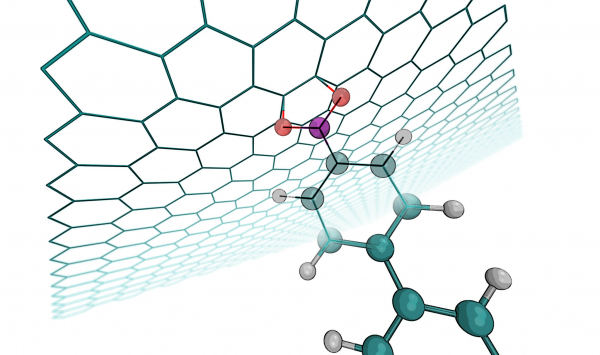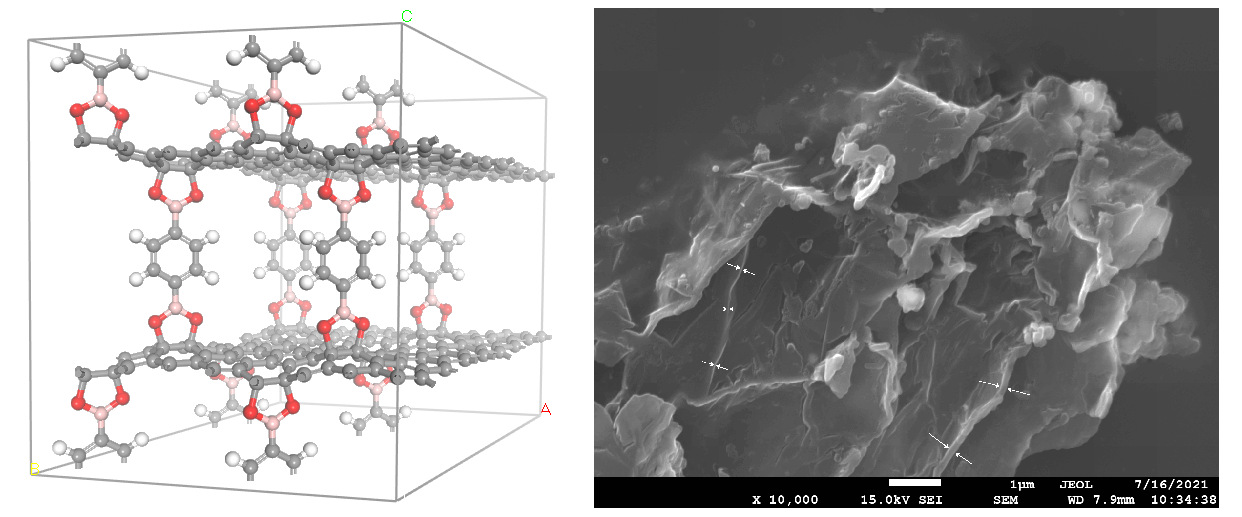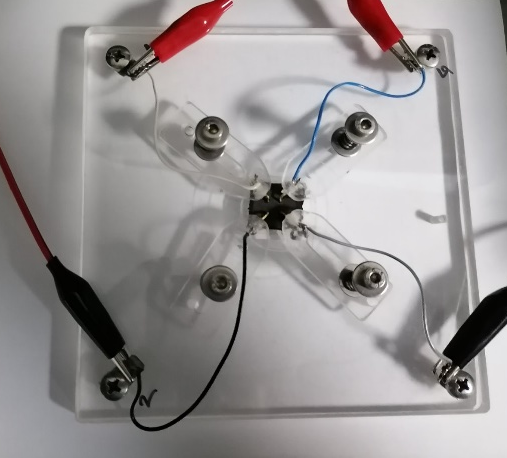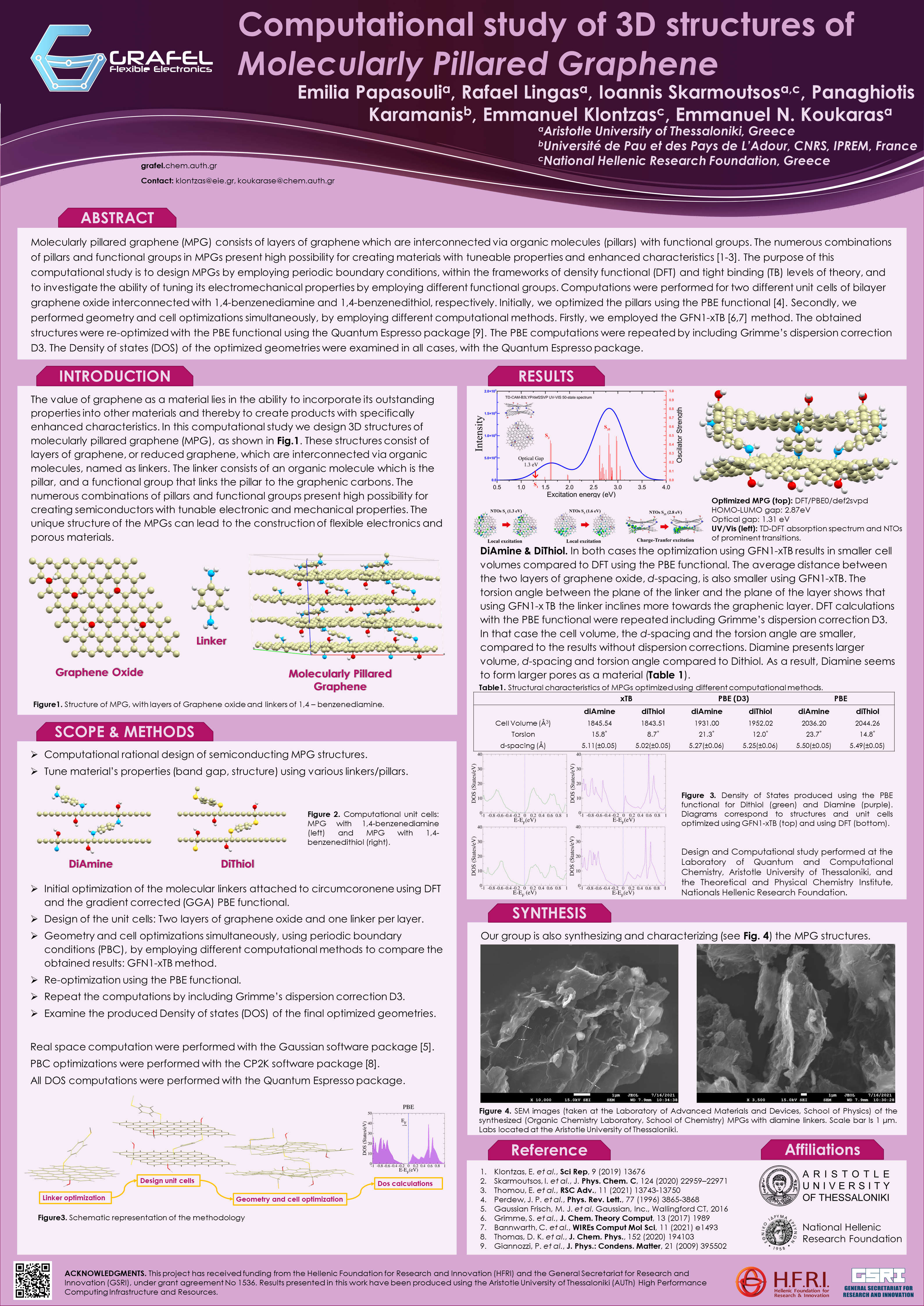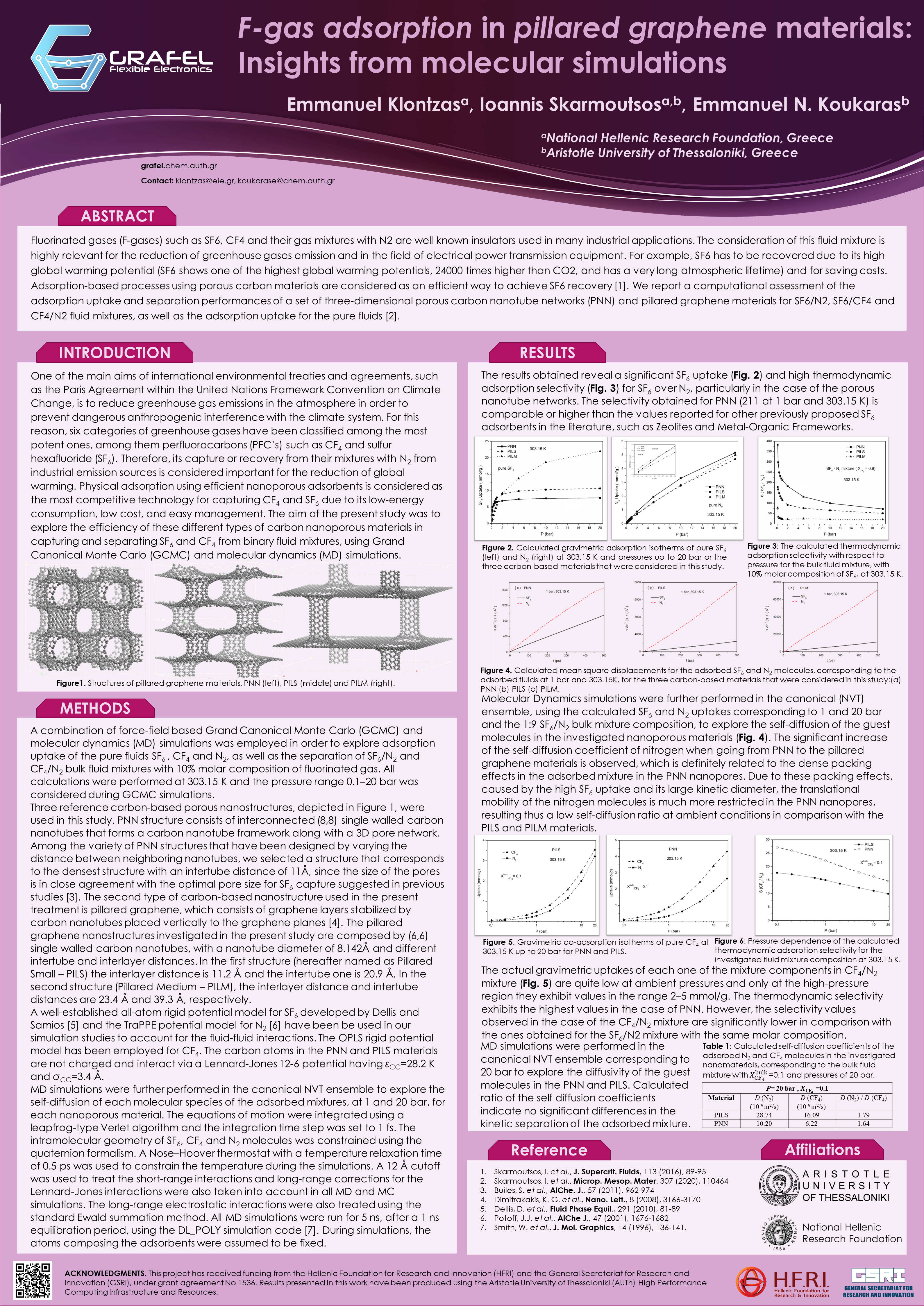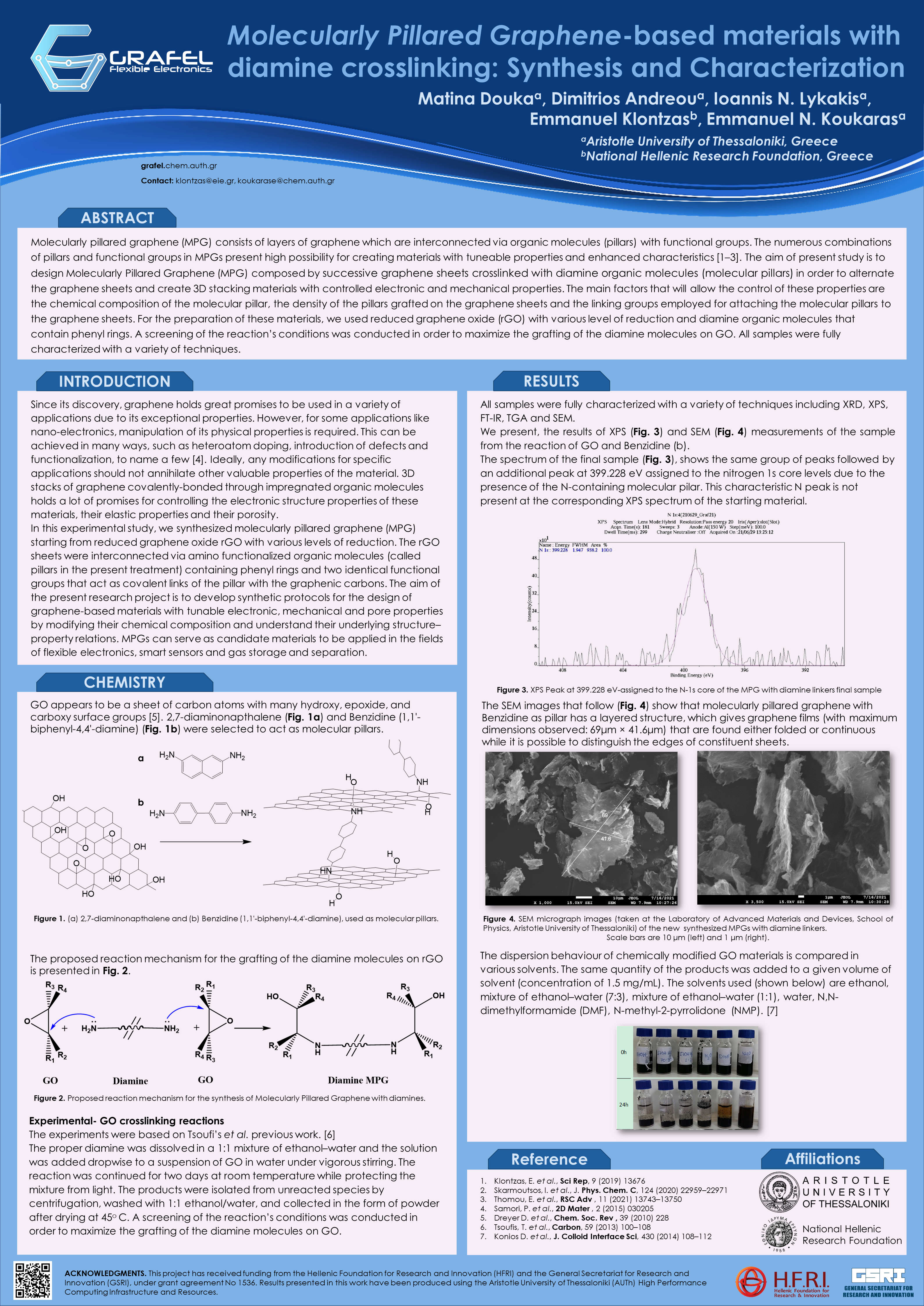Current technological developments have made it necessary to have cheap electronic devices with a large surface area that can be deposited or printed on flexible substrates. The big challenge in the field is to overcome disadvantages of semiconductor inorganic and organic materials and replace them with new materials that combine the advantages of both categories. Such materials can be used in a variety of applications such as detectors with multiple / combined usages, smart clothing, energy storage / transfer, flexible imaging, etc.
The ambition of the GRAFEL research project was to create a new field of research on flexible graphene-based electronic materials and to bring it to a high level of maturity by defining processes concerning
The aim was to design new pillared nanomaterials based on graphene and its derivatives that will have controlled electronic and mechanical properties through changes in their chemical composition. The ultimate goal in terms of design of new materials is to lead to the possibility of constructing devices and to minimize problems (heat removal, electrical contact resistance) associated with the formed interfaces that commonly result from combination of materials of different nature.
The research approach we followed was a combination of a computer-aided design and exploration of the materials properties along with extensive synthesis and characterization of the materials with a variety of methods, with the link being the systematic feedback of data from both sides to maximize the capability to design these materials. In other words, we pursued a materials-based-design strategy that combines theory and experiment to understand the structure-property relationship and to create new materials with desirable properties
Molecularly Pillared Graphenes (MPGs) that were designed, synthesized and studied consist of graphene sheets and / or their derivatives, which are covalently linked together by selected organic molecules that act as "organic" bridges (or pillars) between the sheets. The molecular pillars are attached to graphene sheets via formation of covalent bonds formed by the reaction of the functional groups of pillars and sheets. During the Project, a large number of organic molecules were examined as possible molecular pillars, with emphasis on molecules containing aromatic rings, considering previous knowledge of the research team, conclusions of the current research and influences from other areas of the literature. One criterion for selecting the organic molecules was their ability to promote energy transfer processes as well as the type of chemical bonding to facilitate charge transfer and electronic communication between the graphene sheets.
The conversion of two-dimensional graphene into an innovative three-dimensional material allows the regulation of mechanical properties, the prevention of the adhesion of sheets and the formation of the interlayer distance (regulation of pores). In addition, the electronic properties are regulated by modifying the chemical composition of the material by a) selecting suitable organic molecules as the pillar, b) varying the pillar density and c) changing the type of chemical bonding of the pillars onto graphene. However, we found that some factors play a more decisive role than others. The huge number of possible combinations of the structural parameters of the materials establishes a new area of research with subcategories of materials and applications that reaches far beyond the limits of the Project. In the GRAFEL Project, detailed protocols of chemical synthesis and modeling and methodologies were developed that will be used in our future research as a continuation of the object of the present Project.
In the course, individual properties of constituent materials were studied, such as optical properties of significantly more complex molecular structures that can potentially function as photosensitive organic pillars, as well as complex mechanical properties such as distinct hierarchical morphologies that manifest of graphene sheets under bending and / or small mechanical load (deformation).
The GRAFEL Research Project aimed at designing and developing innovative graphene-based nanostructured materials with controlled electronic and mechanical properties. Materials with these characteristics are suitable candidates for use in flexible electronic devices intended for applications such as photovoltaics, chemical detection, photocatalysis and others. The research methodology used in the design of these new materials consisted of three components that included:
Using a range of computational techniques (ranging from quantum chemistry techniques from first principles to semi-empirical and empirical), the structural, electronic and mechanical properties of the new pillared graphenes have been studied by systematically modifying their chemical composition:
The computations performed include molecular mechanics calculations and calculations of the electronic structure in finite and periodic physical systems, in order to achieve a more complete understanding of the natural phenomena that occur in the materials under study. The computational study showed that all the above structural features can change the electronic properties of these materials from semiconductor to semi-metallic. The most important changes come from the density of the pillars between the graphene sheets and the relative dispersion of the pillars that are covalently bonded above and below the same graphene sheet. The chemical composition of the pillars has an effect in the case of materials with the maximum density of pillars, while the functional groups added on the pillars do not have a significant effect. Increasing the length of the pillars perpendicular to the graphene sheets reduces both the bulk modulus and the shear modulus while both moduli decrease with decreasing pillar density. In addition, the variation of the electronic properties of these materials was studied when mechanical stresses are applied to them, to assess their suitability for usage in flexible electronic devices.
We developed and implemented synthetic processes and extensively characterized the New Materials and redefined synthetic processes. Synthetic processes for the raw materials, graphene oxide and reduced graphene oxide, the pillar structures, the binding groups, and the pillared graphene structures were adopted, followed by multifaceted characterization of the synthesized compounds. A comparison was made between the results of different (redesigned) synthetic protocols and all this in relation to the computational results. Through these experiments we identified the ideal chemical composition for GO for the synthesis of New Materials with well-defined structural characteristics.
The so developed Chemistry Protocol concerning the organic chemical composition, includes:
We point out that we have ascertained the very important effect of the substrate and the quality of the graphene oxide raw material on the final properties and characteristics of the New Materials. With a large series of trial & error experiments, we identified the most suitable substrates for the composition of the New Materials.
With the GRAFEL Research Project, the Research Team acquired the necessary know-how to establish itself in the research field and laid the foundations for the relevant research to continue at a higher level of technological readiness (TRL level). An important step in this direction is the selection of combinations of molecular structures that can better lead to New Materials with desirable properties such as solubility and ease of preparation of considerable quantities with low-cost and environmentally friendly chemical processes. Among the important findings is the identification of properties and applications for which the New Materials would not be suitable or efficient.
Indicatively we could mention that these materials can be used for the development of flexible electronic devices on rigid and flexible substrates and can be used for:
The computational and experimental methodology developed during the project is the basis for the further design and study of supported two-dimensional materials for the development of new heterostructures that will combine their properties.
Ioannis Skarmoutsos, Emmanuel N. Koukaras, Emmanuel Klontzas, ACS Applied Nano Materials (2022), ACCEPTED, Computational Study on Phenyldiboronic Acid-Pillared Graphene Oxide Frameworks for Gas Storage and Separation,
Ioannis Skarmoutsos, Emmanuel N. Koukaras, and Emmanuel Klontzas, CF4 Capture and Separation of CF4−SF6 and CF4−N2 Fluid Mixtures Using Selected Carbon Nanoporous Materials and Metal Organic Frameworks: A Computational Study. ACS Omega 7, 6691−6699 (2022). DOI: 10.1021/acsomega.1c06167
Ioannis Skarmoutsos, Emmanuel N. Koukaras, Emmanuel Klontzas, Gas storage and separation using three-dimensional pillared graphene oxide frameworks with phenyldiboronic acid linkers: A computational approach, Graphene2021. October 26-29, 2021 Grenoble (France).
Emilia Papasouli, Rafael Lingas, Ioannis Skarmoutsos, Emmanuel Klontzas, Emmanuel N. Koukaras, Computational Study of 3D Structures of Pillared Graphene, Graphene2021. October 26-29, 2021 Grenoble (France).
Emmanuel N. Koukaras, Ioannis Skarmoutsos, Emmanuel Klontzas, Confined Ionic Liquids (IL) in carbon-based materials for CO2/CH4 separation: insights from computer simulations, Graphene2021. October 26-29, 2021 Grenoble (France).
Emmanuel Klontzas, Ioannis Skarmoutsos, Emmanuel N. Koukaras, F-gas adsorption in pillared graphene materials. Insights from molecular simulations, Graphene2021. October 26-29, 2021 Grenoble (France).
Matina Douka, Dimitrios Andreou, Ioannis N. Lykakis, Emmanuel Klontzas, Emmanuel N. Koukaras, Molecularly Pillared Graphene-based materials with diamine crosslinking: Synthesis and Characterization, Graphene2021. October 26-29, 2021 Grenoble (France).
Ioannis Skarmoutsos, Emmanuel N. Koukaras, and Emmanuel Klontzas, The Impact of Ionic Liquid Loading in Three-Dimensional Carbon Nanotube Networks on the Separation of CO2/CH4 Fluid Mixtures: Insights from Molecular Simulations, J. Phys. Chem. C 125, 13508−13522 (2021). DOI: 10.1021/acs.jpcc.1c00346.
Emilia Papasouli, Rafael Lingas, Ioannis Skarmoutsos, Emmanuel Klontzas, Emmanuel N. Koukaras, Molecularly Pillared Graphene with Dithiolene and Diamine Linking Groups, Proceedings International 3(3), 27 – 28 (2021). DOI: 10.33263/Proceedings33.027028
I. Skarmoutsos, R. Lingas, E. N. Koukaras, E. Klontzas, Role of the Loading of Ionic Liquid [EMIM]+ [BF4]- in the Separation of CO2/CH4 in 3D Carbon Nanotube Networks, XXXV Panhellenic Conference on Solid State Physics and Materials Science Conference, Athens, 26–29 September 2021.
M. Douka, D. Andreou, I. N. Lykakisa, E. Klontzas, E. N. Koukaras, Synthesis and characterization of 3D graphene-based materials with diamine crosslinking, XXXV Panhellenic Conference on Solid State Physics and Materials Science Conference, Athens, 26–29 September 2021.
I. Skarmoutsos, E. N. Koukaras, C. Galiotis, G.E. Froudakis, E. Klontzas, SF6 Capture and Separation of SF6-N2 Fluid Mixtures Using Porous Carbon Nanotube Networks and Pillared Graphene Materials, XXXV Panhellenic Conference on Solid State Physics and Materials Science Conference, Athens, 26–29 September 2021.
E. Papasouli, R. Lingas, I. Skarmoutsos, E. Klontzas, E. N. Koukaras, Molecularly Pillared Graphene with Dithiolene and Diamine Linking Groups, XXXV Panhellenic Conference on Solid State Physics and Materials Science Conference, Athens, 26–29 September 2021.
Ioannis Skarmoutsos, Emmanuel N. Koukaras, George E. Froudakis, Guillaume Maurin, and Emmanuel Klontzas, Confinement Effects on the Properties of Polar Hydrogen-Bonded Fluids: A Showcase on Methanol Adsorbed in Three-Dimensional Pillared Graphene and Carbon Nanotube Networks, J. Phys. Chem. C 124, 22959−22971 (2020). DOI: 10.1021/acs.jpcc.0c06289
Ch. Androulidakis, D. Sourlantzis, E. N. Koukaras, A. C. Manikas, and C. Galiotis, Stress-transfer from polymer substrates to monolayer and few-layer graphenes, Nanoscale Adv. 1, 4972 (2019), DOI: 10.1039/c9na00323a
Mukhaned L. Keshtov, Serge. A. Kuklin, Ionv. O. Konstantinov, Alexei R. Khokhlov, Zhiyuan Xie, Chuandong Dou, Emmanuel N. Koukaras, Rakesh Suthar, and Ganesh D. Sharma, Synthesis and Photovoltaic Properties of New Conjugated D-A Polymers Based on the Same Fluoro-Benzothiadiazole Acceptor Unit and Different Donor Units, ChemistrySelect 5, 853–863 (2020). DOI: 10.1002/slct.201904353
Lambros Seremetis, Emmanuel N. Koukaras, Sotiria Alexandri, Antonis Michail, George Kalosakas, John Parthenios, Costas Galiotis, Sotirios Tsirkas, Spyridon Grammatikopoulos, and Konstantinos Papagelis, Thermomechanical Response of Supported Hexagonal Boron Nitride Sheets of Various Thicknesses, J. Phys. Chem. C 124, 12134–12143 2020. DOI: 10.1021/acs.jpcc.0c01029
M.L. Keshtova, S.A. Kuklina, I.O. Konstantinova, I.E. Ostapova,b, Zh. Xiec, Emmanuel N. Koukarasd, Rakesh Suthare, Ganesh D. Sharma, New Donor-Acceptor polymers with a wide absorption range for photovoltaic applications, Solar Energy 205, 211–220 (2020). DOI: 10.1016/j.solener.2020.05.059
Mukhamed L. Keshtov, Sergei A. Kuklin, Chuandong Dou, Emmanuel N. Koukaras, Rahul Singhal, Prateek Malhotra, Ganesh D. Sharma, Enhancement of photovoltaic efficiency through fine adjustment of indacene-based non-fullerene acceptor by minimal chlorination for polymer solar cells, Nano Select 1–14 (2020). DOI: 10.1002/nano.202000027
Charalampos Androulidakis, Emmanuel N. Koukaras, George Paterakis, George Trakakis & Costas Galiotis, Tunable macroscale structural superlubricity in two-layer graphene via strain engineering, Nature Communications 11:1595 (2020). DOI: 10.1038/s41467-020-15446-y
Charalampos Androulidakis, Emmanuel N. Koukaras, Krishna Sampathkumar, Jaroslava Rahova, Costas Galiotis, Otakar Frank, Hierarchy of nanoscale graphene wrinkles on compliant substrate: Theory and experiment, Extreme Mechanics Letters 40, 100948 (2020). DOI: 10.1016/j.eml.2020.100948
Ioannis Skarmoutsos, Emmanuel N. Koukaras, Costas Galiotis, George E. Froudakis, Emmanuel Klontzas, Porous carbon nanotube networks and pillared graphene materials exhibiting high SF6 adsorption uptake and separation selectivity of SF6/N2 fluid mixtures: A comparative molecular simulation study, Microporous and Mesoporous Materials 307, 110464 (2020). DOI: 10.1016/j.micromeso.2020.110464
Emmanuel Klontzas, and George E. Froudakis, Unraveling the effect of pillar density and distribution on the electronic properties of molecularly pillared graphene frameworks, Συνέδριο Μεταπτυχιακών Κρήτης Μάιος 2019.
Alexandros G. Chronis, Michael M. Sigalas, Emmanuel N. Koukaras, Absorption spectrum of magnesium and aluminum hydride nanoparticles, Materials Chemistry and Physics 228 (2019) 244–253. DOI: 10.1016/j.matchemphys.2019.02.081
Krishna Sampathkumar, Charalampos Androulidakis, Emmanuel N. Koukaras, Jaroslava Rahova, Karolina Drogowska, Martin Kalbac, Aliaksei Vetushka,Antonin Fejfar, Costas Galiotis, Otakar Frank, Sculpturing graphene wrinkle patterns into compliant substrates, Carbon 146 (2019) 772–778. DOI: 10.1016/j.carbon.2019.02.041
E. Klontzas, E. Tylianakis, V. Varshney, A. K. Roy & G. E . Froudakis, Organically interconnected graphene flakes: A flexible 3-D material with tunable electronic bandgap, Scientific Reports 9:13676 (2019). DOI: 10.1038/s41598-019-50037-y
Ioannis Skarmoutsos, Emmanuel Klontzas, Emmanuel N. Koukaras, Guillaume Maurin, Computational modelling of nanoporous materials for sustainable energy and environmental applications, 12o Πανελλήνιο Επιστημονικό Συνέδριο Χημικής Μηχανικής Αθήνα, 29–31 Μαΐου 2019
Ε. Κλώντζας, Γ. Ε. Φρουδάκης, Ι. Σκαρμούτσος, Κ. Γαλιώτης, Ε. Ν. Κουκάρας, Structural, electronic and mechanical properties of molecularly pillared, 3D nanoporous graphene materials, 12o Πανελλήνιο Επιστημονικό Συνέδριο Χημικής Μηχανικής Αθήνα, 29–31 Μαΐου 2019


